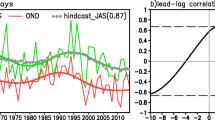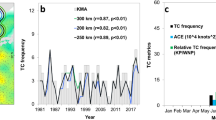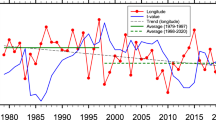Abstract
Based on satellite data after 1979, we find that the tropical cyclone (TC) variations in the Western North Pacific (WNP) can be divided into three-periods: a high-frequency period from 1979 to 1997 (P1), a low-frequency period from 1998 to 2010 (P2), and a high-frequency period from 2011 to 2020 (P3). Previous studies have focused on WNP TC activity during P1 and P2. Here we use observational data to study the WNP TC variation and its possible mechanisms during P3. Compared with P2, more TCs during P3 are due to the large-scale atmospheric favorable conditions of vertical velocity, relative vorticity and relative humidity. Warm sea surface temperature (SST) anomalies are found during P3 and migrate from east to west, which is also favorable for TC genesis. The correlation between the WNP TC frequency and SST shows a significant positive correlation around the equator and a significant negative correlation around 36°N, which is similar to the warm phase of the Pacific Decadal Oscillation (PDO). The correlation coefficient between the PDO and TC frequency is 0.71, above the 95% confidence level. The results indicate that the increase of the WNP TC frequency during 2011–2020 is associated with the PDO and warm SST anomalies.











Similar content being viewed by others
References
Bister M, Emanuel KA (1997) The genesis of Hurricane Guillermo: TEXMEX analyses and a modeling study. Mon Weather Rev 125:2662–2682. https://doi.org/10.1175/1520-0493(1997)1252.0.CO;2
Chen JM, Chen HS, Liu JS (2013) Coherent interdecadal variability of tropical cyclone rainfall and seasonal rainfall in taiwan during october. J Clim 26:308–321. https://doi.org/10.1175/JCLI-D-11-00697.1
Choi JW, Kim HD (2019) Negative relationship between Korea landfalling tropical cyclone activity and Pacific Decadal Oscillation. Dyn Atmos Ocean 87:101100. https://doi.org/10.1016/j.dynatmoce.2019.101100
Choi Y, Ha KJ, Ho CH, Chung CE (2015) Interdecadal change in typhoon genesis condition over the western North Pacific. Clim Dyn 45:3243–3255. https://doi.org/10.1007/s00382-015-2536-y
He H, Yang J, Gong D et al (2015) Decadal changes in tropical cyclone activity over the western North Pacific in the late 1990s. Clim Dyn 45:3317–3329. https://doi.org/10.1007/s00382-015-2541-1
Hsu PC, Chu PS, Murakami H, Zhao X (2014) An abrupt decrease in the late-season typhoon activity over the Western North Pacific. J Clim 27:4296–4312. https://doi.org/10.1175/JCLI-D-13-00417.1
Huang B, Thorne PW, Banzon VF et al (2017) Extended reconstructed sea surface temperature, Version 5 (ERSSTv5): Upgrades, validations, and intercomparisons. J Clim 30:8179–8205. https://doi.org/10.1175/JCLI-D-16-0836.1
Kalnay E, Kanamitsu M, Kistler R, et al (1996) The NCEP/NCAR 40-Year Reanalysis Project. Bull Am Meteorol Soc 77:437–471. https://doi.org/10.1175/1520-0477(1996)0772.0.CO;2
Kim HK, Seo KH, Yeh SW et al (2020) Asymmetric impact of Central Pacific ENSO on the reduction of tropical cyclone genesis frequency over the western North Pacific since the late 1990s. Clim Dyn 54:661–673. https://doi.org/10.1007/s00382-019-05020-8
Kim HM, Webster PJ, Curry JA (2011) Modulation of North Pacific tropical cyclone activity by three phases of ENSO. J Clim 24:1839–1849. https://doi.org/10.1175/2010JCLI3939.1
Kim JH, Ho CH, Kim HS et al (2008) Systematic variation of summertime tropical cyclone activity in the western North Pacific in relation to the Madden-Julian oscillation. J Clim 21:1171–1191. https://doi.org/10.1175/2007JCLI1493.1
Knutson TR, McBride JL, Chan J et al (2010) Tropical cyclones and climate change. Nat Geosci 3:157–163. https://doi.org/10.1038/ngeo779
Li RCY, Zhou W (2013) Modulation of western North Pacific tropical cyclone activity by the ISO. Part I: Genesis and intensity. J Clim 26:2904–2918. https://doi.org/10.1175/JCLI-D-12-00210.1
Li RCY, Zhou W (2014) Interdecadal change in South China Sea tropical cyclone frequency in association with zonal sea surface temperature gradient. J Clim 27:5468–5480. https://doi.org/10.1175/JCLI-D-13-00744.1
Lin II, Chan JCL (2015) Recent decrease in typhoon destructive potential and global warming implications. Nat Commun 6. https://doi.org/10.1038/ncomms8182
Liu C, Zhang W, Geng X et al (2019) Modulation of tropical cyclones in the southeastern part of western North Pacific by tropical Pacific decadal variability. Clim Dyn 53:4475–4488. https://doi.org/10.1007/s00382-019-04799-w
Liu KS, Chan JCL (2020) Recent increase in extreme intensity of tropical cyclones making landfall in South China. Clim Dyn 55:1059–1074. https://doi.org/10.1007/s00382-020-05311-5
Liu KS, Chan JCL, Kubota H (2021) Meridional oscillation of tropical cyclone activity in the western North Pacific during the past 110 years. Clim Change 164. https://doi.org/10.1007/s10584-021-02983-8
Mei W, Xie SP (2016) Intensification of landfalling typhoons over the northwest Pacific since the late 1970s. Nat Geosci 9:753–757. https://doi.org/10.1038/ngeo2792
Mendelsohn R, Emanuel K, Chonabayashi S, Bakkensen L (2012) The impact of climate change on global tropical cyclone damage. Nat Clim Chang 2:205–209. https://doi.org/10.1038/nclimate1357
Molinari J, Vollaro D, Skubis S, Dickinson M (2000) Origins and mechanisms of eastern Pacific tropical cyclogenesis: A case study. Mon Weather Rev 128:125–139. https://doi.org/10.1175/1520-0493(2000)1282.0.CO;2
Murakami H, Wang B, Kitoh A (2011) Future change of western North Pacific typhoons: Projections by a 20-km-mesh global atmospheric model. J Clim 24:1154–1169
Nolan DS, Rappin ED, Emanuel KA (2007) Tropical cyclogenesis sensitivity to environmental parameters in radiative-convective equilibrium. Q J R Meteorol Soc 133:2085–2107. https://doi.org/10.1002/qj.170
Peduzzi P, Chatenoux B, Dao H et al (2012) Global trends in tropical cyclone risk. Nat Clim Chang 2:289–294. https://doi.org/10.1038/nclimate1410
Rayner NA, Parker DE, Horton EB et al (2003) Global analyses of sea surface temperature, sea ice, and night marine air temperature since the late nineteenth century. J Geophys Res Atmos 108. https://doi.org/10.1029/2002jd002670
Ritchie EA, Holland GJ (1997) Scale interactions during the formation of typhoon irving. Mon Weather Rev 125:1377–1396. https://doi.org/10.1175/1520-0493(1997)1252.0.CO;2
Song J, Duan Y, Klotzbach PJ (2020) Increasing trend in rapid intensification magnitude of tropical cyclones over the western North Pacific. Environ Res Lett 15. https://doi.org/10.1088/1748-9326/ab9140
Song J, Duan Y, Klotzbach PJ (2020b) Differences in western North Pacific tropical cyclone activity among three El Niño phases. J Clim 33:7983–8002. https://doi.org/10.1175/JCLI-D-20-0162.1
Timmermann A, An S, Il, Kug JS et al (2018) El Niño–Southern Oscillation complexity. Nature 559:535–545. https://doi.org/10.1038/s41586-018-0252-6
Trenberth KE, Caron JM (2000) The southern oscillation revisited: Sea level pressures, surface temperatures, and precipitation. J Clim 13:4358–4365. https://doi.org/10.1175/1520-0442(2000)0132.0.CO;2
Tu JY, Chou C, Chu PS (2009) The abrupt shift of typhoon activity in the vicinity of Taiwan and its association with western North Pacific-East Asian climate change. J Clim 22:3617–3628. https://doi.org/10.1175/2009JCLI2411.1
Vecchi GA, Soden BJ (2007) Effect of remote sea surface temperature change on tropical cyclone potential intensity. Nature 450:1066–1070. https://doi.org/10.1038/nature06423
Vu T, Kieu C, Chavas D, Wang Q (2020) A numerical study of the global formation of tropical cyclones. J Adv Model Earth Syst 1–33. https://doi.org/10.1029/2020ms002207
Walsh KJE, Sharmila S, Thatcher M et al (2020) Real world and tropical cyclone world. Part II: Sensitivity of tropical cyclone formation to uniform and meridionally varying sea surface temperatures under aquaplanet conditions. J Clim 33:1473–1486. https://doi.org/10.1175/JCLI-D-19-0079.1
Wang B, Chan JCL (2002) How strong ENSO events affect tropical storm activity over the western North Pacific. J Clim 15:1643–1658. https://doi.org/10.1175/1520-0442(2002)0152.0.CO;2
Wang C, Wu K, Wu L et al (2021) What caused the unprecedented absence of western North Pacific tropical cyclones in July 2020? Geophys Res Lett 48:1–9. https://doi.org/10.1029/2020GL092282
Wang Q, Li J, Li Y et al (2018) Modulation of tropical cyclogenesis location and frequency over the Indo-western North Pacific by the intraseasonal Indo-western Pacific convection oscillation during the boreal extended summer. J Clim 31:1435–1450. https://doi.org/10.1175/JCLI-D-17-0085.1
Wang X, Wang C, Zhang L, Wang X (2015) Multidecadal variability of tropical cyclone rapid intensification in the western North Pacific. J Clim 28:3806–3820. https://doi.org/10.1175/JCLI-D-14-00400.1
Yamaguchi M, Chan JCL, Moon IJ et al (2020) Global warming changes tropical cyclone translation speed. Nat Commun 11:1–7. https://doi.org/10.1038/s41467-019-13902-y
Yang L, Chen S, Wang C et al (2018) Potential impact of the Pacific Decadal Oscillation and sea surface temperature in the tropical Indian Ocean–Western Pacific on the variability of typhoon landfall on the China coast. Clim Dyn 51:2695–2705. https://doi.org/10.1007/s00382-017-4037-7
Yokoi S, Takayabu YN (2013) Attribution of decadal variability in tropical cyclone passage frequency over the western North Pacific: A new approach emphasizing the genesis location of cyclones. J Clim 26:973–987. https://doi.org/10.1175/JCLI-D-12-00060.1
Zhan R, Wang Y, Wu CC (2011) Impact of SSTA in the east Indian Ocean on the frequency of northwest Pacific tropical cyclones: A regional atmospheric model study. J Clim 24:6227–6242. https://doi.org/10.1175/JCLI-D-10-05014.1
Zhan R, Wang Y, Ying M (2012) Seasonal forecasts of tropical cyclone activity over the western North Pacific: A Review. Trop Cyclone Res Rev 1:307–324. https://doi.org/10.6057/2012TCRR03.07
Zhang G, Zeng G, Li C, Yang X (2020) Impact of PDO and AMO on interdecadal variability in extreme high temperatures in North China over the most recent 40-year period. Clim Dyn 54:3003–3020. https://doi.org/10.1007/s00382-020-05155-z
Zhang Q, Wu L, Liu Q (2009) Tropical cyclone damages in China 1983–2006. Bull Am Meteorol Soc 90:489–495. https://doi.org/10.1175/2008BAMS2631.1
Zhang W, Leung Y, Fraedrich K (2015) Different El Niño types and intense typhoons in the Western North Pacific. Clim Dyn 44:2965–2977. https://doi.org/10.1007/s00382-014-2446-4
Zhang W, Vecchi GA, Murakami H et al (2018) Dominant role of Atlantic Multidecadal Oscillation in the recent decadal changes in western North Pacific tropical cyclone activity. Geophys Res Lett 45:354–362. https://doi.org/10.1002/2017GL076397
Zhang W, Vecchi GA, Villarini G et al (2017) Modulation of western North Pacific tropical cyclone activity by the Atlantic Meridional Mode. Clim Dyn 48:631–647. https://doi.org/10.1007/s00382-016-3099-2
Zhang X, Zhong S, Wu Z, Li Y (2018b) Seasonal prediction of the typhoon genesis frequency over the western North Pacific with a Poisson regression model. Clim Dyn 51:4585–4600. https://doi.org/10.1007/s00382-017-3654-5
Zhao H, Wang C (2016) Interdecadal modulation on the relationship between ENSO and typhoon activity during the late season in the western North Pacific. Clim Dyn 47:315–328. https://doi.org/10.1007/s00382-015-2837-1
Zhao H, Wang C (2019) On the relationship between ENSO and tropical cyclones in the western North Pacific during the boreal summer. Clim Dyn 52:275–288. https://doi.org/10.1007/s00382-018-4136-0
Zhao J, Zhan R, Wang Y, Xu H (2018) Contribution of the interdecadal pacific oscillation to the recent abrupt decrease in tropical cyclone genesis frequency over the western North Pacific since 1998. J Clim 31:8211–8224. https://doi.org/10.1175/JCLI-D-18-0202.1
Zhao K, Zhao H, Raga GB et al (2021) Changes in extended boreal summer tropical cyclogenesis associated with large-scale flow patterns over the western North Pacific in response to the global warming hiatus. Clim Dyn 56:515–535. https://doi.org/10.1007/s00382-020-05486-x
Acknowledgements
We thank two anonymous reviewers for their comments that have greatly helped improve the manuscript. This study is supported by the National Natural Science Foundation of China (41731173 and 42192564), the National Key R&D Program of China (2019YFA0606701), the Strategic Priority Research Program of the Chinese Academy of Sciences (XDB42000000 and XDA20060502), the Key Special Project for Introduced Talents Team of Southern Marine Science and Engineering Guangdong Laboratory (Guangzhou) (GML2019ZD0306), the Innovation Academy of South China Sea Ecology and Environmental Engineering, the Chinese Academy of Sciences (ISEE2021ZD01), and the Leading Talents of Guangdong Province Program. The numerical simulation is supported by the High Performance Computing Division in the South China Sea Institute of Oceanology.
Author information
Authors and Affiliations
Corresponding author
Additional information
Publisher’s note
Springer Nature remains neutral with regard to jurisdictional claims in published maps and institutional affiliations.
Rights and permissions
About this article
Cite this article
Wang, H., Wang, C. What caused the increase of tropical cyclones in the western North Pacific during the period of 2011–2020?. Clim Dyn 60, 165–177 (2023). https://doi.org/10.1007/s00382-022-06299-w
Received:
Accepted:
Published:
Issue Date:
DOI: https://doi.org/10.1007/s00382-022-06299-w




